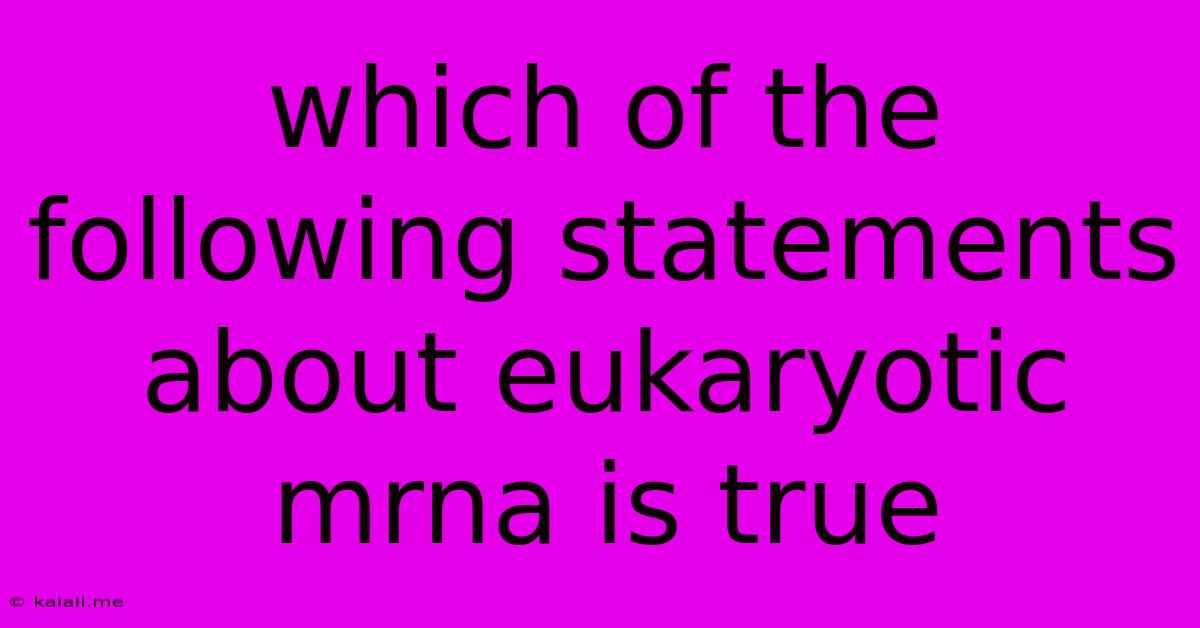Which Of The Following Statements About Eukaryotic Mrna Is True
Kalali
Jun 15, 2025 · 3 min read

Table of Contents
Which of the Following Statements About Eukaryotic mRNA is True? Decoding the Mysteries of Messenger RNA
Understanding eukaryotic mRNA is crucial for grasping the complexities of gene expression and protein synthesis. This article explores the key characteristics of eukaryotic messenger RNA, helping you decipher which statements about it are accurate. We'll delve into the processing steps, structural features, and functional roles of eukaryotic mRNA, providing a comprehensive overview for students and researchers alike.
What is Eukaryotic mRNA?
Eukaryotic mRNA is the intermediary molecule that carries the genetic information from DNA to the ribosomes, the protein synthesis machinery within the cell. Unlike prokaryotic mRNA, eukaryotic mRNA undergoes extensive processing before it can be translated into protein. This processing is crucial for ensuring the stability, localization, and efficient translation of the mRNA.
Key Characteristics and Processing Steps:
Several statements about eukaryotic mRNA could be true or false, depending on the specifics. Let's examine the most common characteristics and potential statements:
1. Eukaryotic mRNA is monocistronic.
This statement is TRUE. Unlike prokaryotic mRNA, which can be polycistronic (coding for multiple proteins), eukaryotic mRNA typically codes for only one protein. Each eukaryotic mRNA molecule is transcribed from a single gene and translates into a single polypeptide chain. This monocistronic nature is a key difference between prokaryotic and eukaryotic gene expression.
2. Eukaryotic mRNA undergoes splicing.
This statement is TRUE. Eukaryotic genes contain introns (non-coding sequences) interspersed with exons (coding sequences). During mRNA processing, a process called splicing, the introns are removed, and the exons are joined together to form a continuous coding sequence. This splicing ensures that only the exons, which contain the genetic information for the protein, are translated. Spliceosomes, complex ribonucleoprotein particles, carry out this crucial splicing process. Alternative splicing can also occur, leading to the production of multiple protein isoforms from a single gene.
3. Eukaryotic mRNA possesses a 5' cap and a 3' poly(A) tail.
This statement is TRUE. The 5' cap (a 7-methylguanosine residue) and the 3' poly(A) tail (a string of adenine nucleotides) are essential post-transcriptional modifications. The 5' cap protects the mRNA from degradation and aids in ribosome binding, while the 3' poly(A) tail enhances mRNA stability and influences its transport to the cytoplasm. These modifications are crucial for ensuring the mRNA's longevity and efficient translation.
4. Eukaryotic mRNA is directly translated without processing.
This statement is FALSE. As discussed above, eukaryotic mRNA undergoes significant processing, including splicing, 5' capping, and 3' polyadenylation, before it can be translated. This processing is essential for its stability and functionality.
5. Eukaryotic mRNA is typically shorter than prokaryotic mRNA.
This statement is generally TRUE but can vary depending on the gene. Because eukaryotic mRNA undergoes splicing, removing non-coding introns, the mature mRNA is often shorter than the initial primary transcript. However, some eukaryotic genes can still produce exceptionally long mRNA molecules.
Conclusion:
Understanding the specific characteristics of eukaryotic mRNA is essential for comprehending the intricacies of gene expression in eukaryotes. The processing steps, such as splicing, 5' capping, and polyadenylation, are critical for the stability, transport, and translation of eukaryotic mRNA. Therefore, statements confirming the monocistronic nature, splicing, and the presence of the 5' cap and 3' poly(A) tail are true concerning eukaryotic mRNA. The statement regarding direct translation without processing is false, highlighting the significant processing requirements. While the length comparison is generally true, exceptions exist. By grasping these fundamentals, one can better appreciate the complexities of eukaryotic gene expression and protein synthesis.
Latest Posts
Latest Posts
-
The Concept Of Emotional Intelligence Was First Introduced By
Jun 15, 2025
-
How To Find Derivative Of An Integral
Jun 15, 2025
-
Alternate Forms Of A Gene Are Produced By
Jun 15, 2025
-
Which Of The Following Is A Probability Sampling Technique
Jun 15, 2025
-
Efflorescence In Bricks Is Caused By
Jun 15, 2025
Related Post
Thank you for visiting our website which covers about Which Of The Following Statements About Eukaryotic Mrna Is True . We hope the information provided has been useful to you. Feel free to contact us if you have any questions or need further assistance. See you next time and don't miss to bookmark.